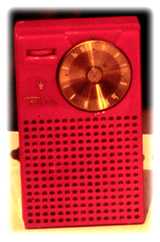| Lou Costello wanted to know the answer to the question "who's on first" for the St. Louis baseball team, but Bud Abbot demonstrated how hard it is to answer such a question (see the Sketch by Bud Abbot and Lou Costello). The same problems of terminology and definition occur in the history of technology. Nick Lyons in The Sony Vision, (N.Y., 1976) claimed that Sony pioneered the "world's first pocket-size all-transistor radio" in March 1957 (page 54). However, Akio Morita in Made in Japan, (N.Y., 1986) wrote that although it was the "world's smallest" it was not the first. "The introduction of this proud achievement was tinged with disappointment that our first transistorized radio was not the very first one on the market" (page 71). That honor belonged to an American company in Indianapolis called I.D.E.A. that announced the production of the Regency TR-1 on October 18, 1954. Michael Schiffer in The Portable Radio in American Life, (Tucson, 1991) wrote that this was "the world's first shirt-pocket portable radio--with transistors" (page 176). The Regency may have been the first commercial transistor radio but Paul Davis has described his development of the first working transistor radio at Texas Instruments in May 1954 (see the Southwestern Historical Quarterly, 1993, pages 56-80). In Germany, Robert Denk may have produced a transistor radio in February of 1948. The germanium transistor was first demonstrated privately at Bell Labs Dec. 23, 1947, by William Shockley and his team. However, production problems delayed its practical use. Until it was perfected, the invention was kept secret for 7 months and no patents were filed until 1948; the first public announcement was June 30, 1948 (Braun and Macdonald, p. 33). Raytheon was first to mass-produce transistors in 1952 and the first to produce a commercial product with transistors, the hearing aid. Amateurs used transistors to design experimental radio circuits as early as 1950 and Western Electric engineers made a wrist radio in 1952 with 4 transistors as a gift for Dick Tracy creator Chester Gould (Schiffer page 174). The Regency claimed in its advertisements that it was the "world's first pocket radio" but Schiffer has chronicled the earlier history of pre-transistor portable radios, such as the Operadio 2 in 1923, the "first stand-alone portable" (page 72), the Zenith Companion in 1924, the "first boom-box advertised nationally" (page 75), and the Belmont Boulevard in 1945, the "world's first commercial shirt-pocket radio" (page 162) using the subminiature tubes developed by Norman Krim at Raytheon in 1939. |  Regency transistor radio of 1954, from Smithsonian Information Age exhibit Regency transistor radio of 1954, from Smithsonian Information Age exhibit |